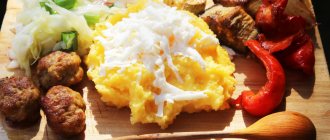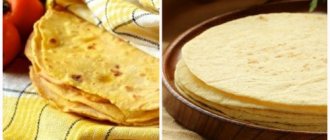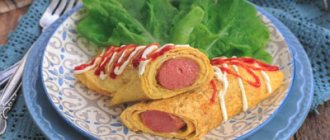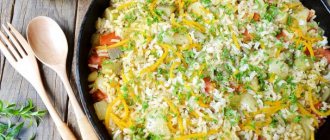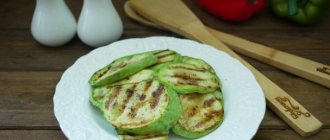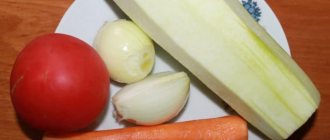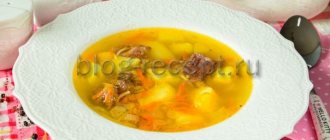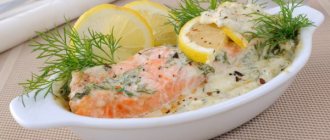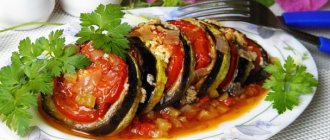The benefits and harms of the dish
Corn grits contain a huge amount of useful microelements and vitamins, due to which porridge made from it must be included in the diet.
Eating this dish helps strengthen bones, increase immunity, and restore the body after illness. It is also beneficial for the digestive system.
The fiber it contains ensures the removal of harmful substances from the body. With frequent consumption of the dish, the amount of cholesterol in the body decreases.
Sometimes it is used for weight loss, because, despite its nutritional value, porridge is distinguished by its ability to remove fat.
But at the same time, you should not overuse the dish, since in this case its positive qualities may decrease. Nutrition should be varied and nutritious so that there is no oversaturation of some substances with a deficiency of others.
Difficulty, cooking time
Preparing the porridge takes about an hour. Working on it is not considered difficult - on the contrary, hominy is easy to do.
During cooking, it is most important to give the porridge the correct consistency, since a negative attitude towards the dish arises precisely because of excessive liquid or thickness.
From corn grits
Ingredients:
- Time: 45 minutes.
- Number of servings: 3 servings.
- Calorie content of the dish: 400 kcal per 100 g.
- Purpose: for breakfast, lunch, dinner.
- Cuisine: Moldavian.
- Difficulty of preparation: easy.
One of the classic Moldavian recipes will help you prepare mamaliga from corn grits quickly and easily. The cereal should be finely ground. This way the porridge will cook much faster and will look like a flatbread - dense, not crumbly, appetizing. Its consistency will be more homogeneous and will acquire a pleasant texture. It is recommended to cook in a cauldron, pot or thick-walled bowl so that the porridge retains its shape.
Ingredients:
- corn grits – 0.5 tbsp.;
- water – 1 tbsp.;
- vegetable oil – 1 tsp.
Cooking method:
- Bring water to a boil in a vat or kettle.
- Add the cereal. Cook for half an hour, stirring.
- Reduce heat, simmer covered for 15 minutes.
- Using a damp spoon, separate the porridge from the walls and shake the pot.
- Present using a tray or board. Recipe 1, classic: hominy (with photo)
Mamalyga is a thick corn porridge that was previously eaten like bread.
- corn flour - 500 gr
- water - 1.3 l
- salt - to taste
Recipe
- Boil water in a cauldron or saucepan with a thick bottom and add sifted flour.
- Bring to a boil, reduce heat to medium, and, stirring constantly for 5-10 minutes, allow to thicken.
- Turn off the heat, cover with a lid, leave for 5 minutes until the water is absorbed and the porridge becomes very thick, but do not stir with a spoon.
- Turn the contents of the cauldron onto a wooden board. Cut into pieces with waxed thread or a knife.
Useful tips
Mamalyga in Moldavian style is not just corn porridge and bread, it is a dish cooked according to all the rules:
- You will need a cauldron or any other thick-walled pan, plus a wooden stirrer, finely ground corn flour, clean water and salt;
- To serve you need a wooden board;
- For slicing, it is better to use a wooden knife or waxed coarse thread;
- Add a little more salt to the dish than to a similar hominy prepared according to a different recipe;
- First, salt is added, and then flour is added.
Although the idea of making bread from corn grits is Moldovan, as is the idea of cooking it in a thick-walled cast iron, stirring with a wooden stick, it is also prepared in many other countries. It’s just that in Moldova they call it mamaliga and cook it from fine corn flour, sometimes adding cracklings.
Recipe 2: Cornmeal hominy
Mamalyga is a traditional Moldavian and Romanian dish, a type of thick porridge made from corn flour. The recipe for mamaliga is very simple; it is an ancient folk dish, as everyday as bread.
- Corn flour - 100 g
- Water - 330 g
- Salt - 3 g (to taste)
Recipe:
- How to cook mamalyga: pour water into a cauldron, put it on the fire, bring to a boil.
- Add salt and a little corn flour (20 g) to boiling water.
- Stirring, bring to a boil.
- After the water boils a second time, pour in all the flour in a heap at once.
- Then split it in two with a stirrer. Cook over low heat for 30 minutes covered.
- Then thoroughly stir all the flour, pressing the stirrer to the sides of the pan. If the hominy is liquid, add a little more corn flour, stirring continuously.
- To determine the degree of readiness of the hominy, lower the stirrer vertically into the pan and quickly rotate it between your palms. If there are no traces of hominy left on the stirrer, the dish is ready. Otherwise, the hominy should be left on the fire.
- Before adding the hominy, scrape the mass from the sides of the pan towards the center with a spoon dipped in water, and leave it on the fire for some more time (2-3 minutes).
- Then shake the pan several times and tip it onto the board. Mamalyga is ready.
- Cut the hominy with a thin cord or wooden knife.
- Mamalyga is served with cracklings, fried onions, cheese and sauce. Bon appetit!
Moldavian mamaliga made from corn flour with cracklings
Moldovans often add cracklings to mamalyga, which is also quite appropriate. The taste of rendered lard is pleasant, a little creamy, and it is especially suitable for corn porridge.
Amount of required ingredients:
- 400 g corn flour (finely ground);
- 300 g fresh lard;
- 400 g sheep's milk cheese;
- salt + pepper – add at your discretion.
You will need to cook: 50 minutes. The value of a serving (100 g) is: 320 kcal.
Recommendations for preparing the dish:
- Take products in the following proportions: 1 part corn flour and 3 parts plain water;
- Gradually add flour to boiling water. Cook over medium heat, stirring constantly. Add salt to your taste;
- Cut the lard into small cubes, place it in a hot frying pan and melt all the fat to make fried pieces of lard;
- If you wish, you can also add natural cheese to the mamalyga. To do this, knead it and place it on the bottom of a heat-resistant form. Place a layer of hominy on top of the cheese, followed by cracklings;
- Place the dish in the preheated oven for 15 minutes;
- Note to the housewife: this recipe will save you time, because hominy can be prepared in excess and stored in the refrigerator.
Recipe 3: Corn hominy
Languid, aromatic and melt-in-your-mouth mamalyga is not only a porridge cooked from corn flour, but also a hearty dish in its own right. It is suitable for all ages, but for children the corn hominy is boiled sweet and liquid, while for adults it is salted and kneaded to such an extent that when served the corn hominy resembles a round bread, especially when it is turned out of the container onto a wooden board or dish. Eaten in the morning, such porridge allows the body to literally not feel hungry all day long, as it perfectly saturates the body. Despite the fact that this porridge was created for the poor and they replaced bread with it, now mamalyga made from corn grits is a dish served in famous restaurants and cafes in various interpretations.
- 200 g corn flour;
- 600 ml hot water;
- 50 g butter;
- 1 teaspoon salt (without top);
- 1-2 pinches of turmeric or curry mixture to give a rich yellow color.
Additional Ingredients:
- 100 g ham or several strips of bacon;
- 100 g salted or fresh lard;
- 100 g of feta cheese (sheep's or cow's brined cheese).
Recipe:
- Since mamalyga is prepared only in a cauldron or dish with thick non-stick walls, it is in such a dish that we pour hot water and put it on the stove, bring it to a boil and add salt.
- Add butter to the water. Moldavian hominy absolutely loves everything fatty and that is why so many fatty and high-calorie additives are used in its preparation.
- By the way, this is the only porridge that not only loves fat, but also water! If other porridges, for example: buckwheat, rice, etc., maintain a ratio of 1:2, that is, 1 part of cereal to 2 parts of water, then corn grits absorb water so much that it only needs to be kneaded at a ratio of 1: 3!
- Sift corn flour through a strainer.
- Add a few pinches of turmeric to it.
- We wait until the water boils and, using a spatula, begin to add flour.
- Add flour in small portions;
- As soon as we add a portion of flour, immediately stir the porridge with a spatula.
- If you are preparing mamalyga for the first time, it is best to use a whisk or even a mixer, turning it on at minimum speed, since the corn porridge instantly brews and clumps into lumps. Don’t be alarmed by this - you need to knead the hominy for 20-30 minutes, constantly pouring flour into it.
- This is a long process, but it is very important for the correct preparation of the dish, so be patient and go ahead! By the way, during the process of kneading into mamalyga, the recipe for which is not so labor-intensive, you can add all kinds of aromatic spices and seasonings - of your choice.
- After the porridge begins to “puff” in a cauldron or non-stick dish, knead it for about 5-10 minutes and transfer it to a round shape: a bowl, baking dish or silicone mold.
- Cover with a clean towel and place in a warm place - the cooked porridge should still reach the desired condition and set within 15-20 minutes. Don't worry, it will stay hot and fragrant in the middle.
- While the hominy is arriving, it’s time to prepare a frame for it using additional products. Cut the lard into small proportional pieces, and the ham into slices.
- In a hot frying pan, without adding fat, fry both lard and ham until golden brown on both sides.
- Grate the cheese on a coarse grater. But it is also possible to cut it into cubes - this design also looks beautiful and aesthetically pleasing!
- After the specified time has passed, remove the towel and touch the top layer of porridge in the container. If it has frozen, then the porridge can be turned over onto a wooden board or serving dish. To prevent your hands from shaking, simply cover the top of the container with a board and turn it over sharply, pressing the board against the edges of the container. The hominy should easily separate and fall onto the board, keeping its shape.
- Corn porridge is cut using a wide knife dipped in cold water or greased with any edible oil. But, ideally, such a Moldavian dish is cut with a thin rope soaked in vegetable oil.
Mamaliga recipe in Moldavian style. Calorie, chemical composition and nutritional value.
Nutritional value and chemical composition of Mamalyga in Moldavian style.
The table shows the nutritional content (calories, proteins, fats, carbohydrates, vitamins and minerals) per 100 grams of edible portion.
| Nutrient | Quantity | Norm** | % of the norm in 100 g | % of the norm in 100 kcal | 100% normal |
| Calorie content | 95.7 kcal | 1684 kcal | 5.7% | 6% | 1760 g |
| Squirrels | 1.9 g | 76 g | 2.5% | 2.6% | 4000 g |
| Fats | 3 g | 56 g | 5.4% | 5.6% | 1867 |
| Carbohydrates | 15.8 g | 219 g | 7.2% | 7.5% | 1386 g |
| Alimentary fiber | 1.7 g | 20 g | 8.5% | 8.9% | 1176 g |
| Water | 77.7 g | 2273 g | 3.4% | 3.6% | 2925 g |
| Ash | 1.296 g | ~ | |||
| Vitamins | |||||
| Vitamin A, RE | 19.4 mcg | 900 mcg | 2.2% | 2.3% | 4639 g |
| Retinol | 0.013 mg | ~ | |||
| beta carotene | 0.01 mg | 5 mg | 0.2% | 0.2% | 50000 g |
| Vitamin B1, thiamine | 0.146 mg | 1.5 mg | 9.7% | 10.1% | 1027 g |
| Vitamin B2, riboflavin | 0.091 mg | 1.8 mg | 5.1% | 5.3% | 1978 |
| Vitamin B5, pantothenic | 0.099 mg | 5 mg | 2% | 2.1% | 5051 g |
| Vitamin B6, pyridoxine | 0.126 mg | 2 mg | 6.3% | 6.6% | 1587 g |
| Vitamin B9, folates | 76.92 mcg | 400 mcg | 19.2% | 20.1% | 520 g |
| Vitamin C, ascorbic acid | 0.86 mg | 90 mg | 1% | 1% | 10465 g |
| Vitamin D, calciferol | 0.042 mcg | 10 mcg | 0.4% | 0.4% | 23810 g |
| Vitamin E, alpha tocopherol, TE | 0.049 mg | 15 mg | 0.3% | 0.3% | 30612 g |
| Vitamin H, biotin | 0.077 mcg | 50 mcg | 0.2% | 0.2% | 64935 g |
| Vitamin RR, NE | 1.181 mg | 20 mg | 5.9% | 6.2% | 1693 g |
| Niacin | 0.02 mg | ~ | |||
| Macronutrients | |||||
| Potassium, K | 70.35 mg | 2500 mg | 2.8% | 2.9% | 3554 g |
| Calcium, Ca | 83.65 mg | 1000 mg | 8.4% | 8.8% | 1195 g |
| Magnesium, Mg | 20.26 mg | 400 mg | 5.1% | 5.3% | 1974 |
| Sodium, Na | 280.52 mg | 1300 mg | 21.6% | 22.6% | 463 g |
| Sera, S | 6.49 mg | 1000 mg | 0.6% | 0.6% | 15408 g |
| Phosphorus, P | 177.9 mg | 800 mg | 22.2% | 23.2% | 450 g |
| Chlorine, Cl | 3.07 mg | 2300 mg | 0.1% | 0.1% | 74919 g |
| Microelements | |||||
| Aluminium, Al | 34.2 mcg | ~ | |||
| Bor, B | 17.1 mcg | ~ | |||
| Iron, Fe | 1.308 mg | 18 mg | 7.3% | 7.6% | 1376 g |
| Yod, I | 0.26 mcg | 150 mcg | 0.2% | 0.2% | 57692 g |
| Cobalt, Co | 0.428 mcg | 10 mcg | 4.3% | 4.5% | 2336 g |
| Manganese, Mn | 0.1273 mg | 2 mg | 6.4% | 6.7% | 1571 g |
| Copper, Cu | 40.19 mcg | 1000 mcg | 4% | 4.2% | 2488 g |
| Nickel, Ni | 0.257 mcg | ~ | |||
| Rubidium, Rb | 40.7 mcg | ~ | |||
| Fluorine, F | 69.5 mcg | 4000 mcg | 1.7% | 1.8% | 5755 g |
| Chromium, Cr | 0.17 mcg | 50 mcg | 0.3% | 0.3% | 29412 g |
| Zinc, Zn | 0.5005 mg | 12 mg | 4.2% | 4.4% | 2398 g |
| Digestible carbohydrates | |||||
| Starch and dextrins | 0.009 g | ~ | |||
| Mono- and disaccharides (sugars) | 0.7 g | max 100 g | |||
| Glucose (dextrose) | 0.111 g | ~ | |||
| Sucrose | 0.556 g | ~ | |||
| Fructose | 0.103 g | ~ | |||
| Essential amino acids | 0.024 g | ~ | |||
| Arginine* | 0.102 g | ~ | |||
| Valin | 0.092 g | ~ | |||
| Histidine* | 0.055 g | ~ | |||
| Isoleucine | 0.067 g | ~ | |||
| Leucine | 0.221 g | ~ | |||
| Lysine | 0.055 g | ~ | |||
| Methionine | 0.038 g | ~ | |||
| Methionine + Cysteine | 0.002 g | ~ | |||
| Threonine | 0.07 g | ~ | |||
| Tryptophan | 0.014 g | ~ | |||
| Phenylalanine | 0.091 g | ~ | |||
| Phenylalanine+Tyrosine | 0.006 g | ~ | |||
| Nonessential amino acids | 0.057 g | ~ | |||
| Alanin | 0.138 g | ~ | |||
| Aspartic acid | 0.129 g | ~ | |||
| Glycine | 0.076 g | ~ | |||
| Glutamic acid | 0.351 g | ~ | |||
| Proline | 0.157 g | ~ | |||
| Serin | 0.086 g | ~ | |||
| Tyrosine | 0.075 g | ~ | |||
| Cysteine | 0.033 g | ~ | |||
| Sterols (sterols) | |||||
| Cholesterol | 5.29 mg | max 300 mg | |||
| Saturated fatty acids | |||||
| Saturated fatty acids | 1.6 g | max 18.7 g | |||
| 16:0 Palmitinaya | 0.087 g | ~ | |||
| 18:0 Stearic | 0.012 g | ~ | |||
| Monounsaturated fatty acids | 0.192 g | min 16.8 g | 1.1% | 1.1% | |
| 16:1 Palmitoleic | 0.001 g | ~ | |||
| 18:1 Oleic (omega-9) | 0.191 g | ~ | |||
| Polyunsaturated fatty acids | 0.399 g | from 11.2 to 20.6 g | 3.6% | 3.8% | |
| 18:2 Linolevaya | 0.321 g | ~ | |||
| 18:3 Linolenic | 0.01 g | ~ | |||
| Omega-6 fatty acids | 0.3 g | from 4.7 to 16.8 g | 6.4% | 6.7% |
The energy value of Mamalyga in Moldavian is 95.7 kcal.
Primary Source: Created in the application by the user. Read more.
** This table shows the average levels of vitamins and minerals for an adult. If you want to know the norms taking into account your gender, age and other factors, then use the “My Healthy Diet” application.
Recipe 4: Moldavian-style mamaliga (step by step)
Mamaliga in Moldavian style is prepared very simply at home and is a very densely cooked porridge made from corn flour.
Our step-by-step recipe with photos will tell you in detail and clearly about all the details and subtleties of preparing Moldavian cuisine, and you can easily reproduce the whole process yourself.
To prepare this dish you need a minimum of ingredients and, despite the fact that porridge is considered practically bread, there is no need to bake it.
Under no circumstances should you use ceramic dishes when preparing this porridge; even after cooking, it should be placed on a wooden board. In any other case, the porridge will be covered with perspiration, soften and will no longer resemble Moldavian hominy in both taste and appearance.
You can serve Moldavian-style mamaliga with absolutely any dish, be it meat, pasta or vegetables. This corn porridge will be very appetizing and will delight your whole family.
Let's start preparing corn hominy in Moldavian style.
- corn flour - 2 cups
- water - 6 glasses
- table salt - 1 tsp.
- butter - 20 g
Recipe:
- Pour the indicated amount of water into a deep pan with thick walls or into a kettle. Pour salt into the pan and add a small piece of butter there, pour a handful of corn flour into the water. Mix the ingredients thoroughly and bring the liquid to a boil.
- After the water has reached a boil, pour all the remaining flour into the pan and quickly and thoroughly mix it with the water. Turn on low heat and cook the porridge for 20 minutes.
- Constantly stir the contents of the pan with a wooden spatula so that all the lumps of flour disperse and it cooks evenly. Continue cooking the porridge for another 15 minutes.
- Again, lightly stir the porridge in a saucepan or cauldron, visually divide it into quarters and draw them with a spatula on the surface of the hominy. Cook for another 10 minutes.
- When the water has evaporated sufficiently as shown in the photo, stir it very quickly and thoroughly with a wooden spatula.
- We turn the heat even lower, stir and continue cooking the mamalyga, using the same spatula or spoon to separate the porridge from the walls of the pan. We check the readiness of the porridge in any way convenient for you.
- You can pierce the center of the porridge with a wooden skewer and twist it: if the porridge easily comes off the skewer, it means it is ready. Cover the pan with a wooden cutting board and turn it over: this way our hominy will end up on the board without damage.
- Cut the slightly cooled porridge into threads and serve. Now you know how to cook Moldavian mamaliga in a simple and convenient way.
Preparation
Step-by-step preparation of a delicious dish with accompanying photographs:
1. First, prepare all the above ingredients. Then take a cauldron or saucepan with thick walls/bottom, place it on the stove and pour in a liter of water. Once boiling, add a generous pinch of salt.
2. Then take the cornmeal and pour it in a thin stream into the boiling water. Do not forget that it must be stirred constantly. According to Moldavian traditions, porridge is kneaded not with a spoon, but with a wooden rolling pin. However, if you do not want to follow the national traditions of the recipe, you can use a wooden spoon, but not a metal one.
3. At the next stage of cooking, you need to mix the porridge thoroughly. You need to cook it over very low heat so that it simmers and has time to swell thoroughly. It is advisable to cook the hominy until all the liquid is absorbed.
4. Next, if you want to serve cracklings, use lard. If you want to experiment, you can replace it with regular sausage. Such a recipe does not prohibit introducing your own innovations and changes. In this case, take a piece of good sausage and cut it into small cubes. Then place a frying pan on the stove, pour vegetable oil into it and heat it up. Place the chopped sausage and fry for three to five minutes until it acquires a golden color and crust.
5. Next you need to prepare the omelet. To do this, take a deep bowl, beat three eggs into it and add one hundred milliliters of milk. Then you can add pepper and salt and whisk thoroughly.
6. Heat a frying pan on the stove and pour the prepared egg mixture into it. Continue to fry over medium heat until fully cooked, stirring occasionally.
7. Transfer the finished mamalyga to a dish. Let cool slightly so that you can then serve on serving plates and decorate.
8. Moldavian mamalyga according to the original and unusual recipe is ready. You can serve it to the table, having previously arranged it into portioned plates. Place fried eggs and sausage next to a piece of porridge. You can decorate with fresh herbs and tomatoes. The dish is to die for! You can cook this dish every day, and your household will be very grateful to you.
Moldavian mamalyga is a hearty, nutritious, tasty and aromatic, tender, healthy dish that can be served at the holiday table. Cook with pleasure!
Recipe 5: hominy with cheese and cracklings
Mamalyga is a thick porridge made from corn grits or flour, cooked in water or in water with the addition of milk. Once upon a time in Moldova and Romania, hominy was eaten instead of bread, although even now it is prepared very often. As a rule, hominy is cooked fresh or slightly salted so that it can be served with any food - cottage cheese with sour cream, meat, fried fish with spicy garlic sauce, cracklings, feta cheese, fried eggs or vegetable salad. Often, hominy is poured with hot milk and eaten sweet or salty, and the crust that remains on the walls of the cauldron is dried like crackers. We will prepare mamalyga with cracklings and cheese.
- lard with streaks of meat - 400 g;
- moderate fat pork – 400 g;
- salted sheep cheese - as much as needed;
- water – 3 glasses;
- milk – 1.5 cups;
- finely ground corn grits - 3 cups;
- salt - to taste.
Recipe:
- Remove the skin from the lard and cut into small pieces (2x2 cm in size). Cut the meat into slightly larger pieces. To make it more convenient to cut the meat, put it in the freezer for half an hour - it will harden and will not slip under the knife.
- Heat a frying pan with high sides. First add lard and melt it a little. Make the heat low and add the meat. Fry the meat until it is browned until red.
- Then you need to take it out and put it on a plate, and continue to render the lard. The pieces of lard should become very small, golden brown in color, with a crispy crust. These are cracklings. Remove the pan with cracklings from the stove and cool.
- Boil 3 cups of water in a cauldron with a convex bottom. Then pour in 1.5 cups of milk and boil the liquid again.
- Add a small heaped teaspoon of salt to the milk and water.
- When the milk begins to boil intensely and foam appears on the surface, it’s time to add the corn grits. Pour the cereal into the center of the dish while the milk continues to boil.
- Corn grits are poured into the liquid so that a small mound is formed on the surface. Do not stir the cereal after pouring it into the milk, leave the cauldron on low heat, do not cover with a lid.
- The milk will gradually soak the cereal, it will steam and swell. You need to wait about 15 minutes, and adjust the heat so that the milk boils, but does not run away.
- When the cereal swells, it will gradually begin to sink and settle. Now you need to remove the cauldron from the heat and crush the hominy with a masher, knead it well, knead all the lumps, even the smallest (there may be dry cereal left in them).
- After stirring, the hominy will become thick and lumpy, but there will still be a lot of liquid left in it, and the cereal itself will be poorly steamed. Turn the heat to minimum, cover the hominy with a lid and simmer for 25-30 minutes.
- After this, open the lid slightly, excess moisture needs to evaporate. When all the liquid has evaporated and the hominy becomes dense and hard, turn the heat up to high and keep the hominy for another 5 minutes. This is necessary so that the cereal sticks along the edges and on the bottom of the cauldron, and the hominy can be easily removed from the cauldron.
- The finished hominy is turned over onto a wooden board and the cauldron is removed. If hominy is cooked correctly, it will remain on the board in a high mound and will be dense, but not crumbly. Mamalyga is served hot, with cracklings and fried meat (the cracklings and meat can be heated), with grated sheep cheese and a glass of good homemade wine.
Mamalyga in a slow cooker
With this device you can prepare almost any dish, including mamalyga.
In this case, you will need the following components:
- corn grits – 400 g;
- butter – 60 g;
- water – 1 l;
- salt.
Recipe:
- Boil water in a kettle. The sifted cereal is poured into a bowl, and boiling water is poured into it. The components are supposed to be stirred, salt and butter are added to them. You need to cook the dish for 20 minutes in the “porridge” mode.
Hominy
Ingredients
- Water 1.8 l
- Corn flour 800 g
- Salt 25 g
- Vegetable oil 25-30 ml
Step-by-step preparation
- Take a cast iron cauldron with a thick bottom and pour 1.8 liters of water into it. The dishes must have a thick bottom, as the porridge can burn in a regular pan. Place the cauldron on medium heat and add 25 g of salt there.
- We also add 25-30 ml of any odorless vegetable oil.
- Bring the water to a boil, and then add 800 g of corn flour. Add the flour in small portions, constantly stirring the mixture with a wooden spoon or spatula to prevent lumps from forming. If you don't have cornmeal, use very finely ground cornmeal
- Mix everything thoroughly again, breaking up any lumps if possible.
- Reduce the heat to low, cover the cauldron with a lid and leave the hominy to simmer for 35-40 minutes. During the cooking process, it must be constantly stirred with upward movements so that the porridge does not burn. The spatula can be moistened with plain water to make it easier to stir.
- The finished hominy should separate from the walls of the dish and the wooden spatula. Level its surface with a wet spatula and remove from heat.
- We place a wooden board on the table, and then in one sharp movement we turn the cauldron with hominy onto the board. If necessary, trim it a little and let the porridge cool.
Moldavian mamaliga recipe
What do you need:
- corn flour – 1 part;
- water – 2.5-3 parts;
- salt - to taste;
- butter - 50 g per glass of corn flour.
The number of components should be measured based on volume. For example, you can measure with glasses.
How to cook:
- Place butter in a cauldron and melt it.
- Add salt and water.
- Heat water with oil and salt, add a few tablespoons of corn grits. Stirring to avoid lumps, bring the mixture to a boil. Add the rest of the cereal and stir vigorously until the porridge thickens.
- Cook the porridge until cooked: it should become dense, like pudding.
- Remove from heat, cover with a lid. After 10 minutes, run a spoon along the contour of the porridge and tip the cauldron onto a large dish.
Mamalyga can be immediately divided into plates, or done at the table.
Mamaliga in Georgian
Georgian porridge is a substantial dish. Its preparation is not hasty or careless. But all efforts are fully rewarded!
The main ingredient of a folk dish
To prepare gomi you will need a minimum of ingredients. It is based on corn products.
TIP: local chefs recommend preparing mamalyga from coarse grains and flour at the same time. However, cooking only with flour is allowed.
In the western regions of Georgia, where gomi is a traditional dish, they say that it is better to cook porridge from white corn, but you can also use flour from the usual yellow grains.
What is the best way to cook hominy?
Crushed or ground corn should be thoroughly cooked, soft and tender. Therefore, the food is cooked over low heat. It is also important to use the “correct” dishes, in which the contents will warm up well, but will not burn.
A cauldron is best suited for this. Its advantages include thick walls and a semicircular bottom, which allows the contents to heat up evenly not only at the bottom, but also at the walls of the dish.
TIP: during the cooking process, the contents of the cauldron must be constantly stirred. This is done with a large wooden spatula (or shallow spoon) on a long handle, which should be prepared in advance.


